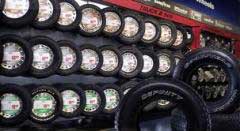How to Choose the Right Size Tire - Vol.118
Selecting the right tire is not as easy as it sounds. When buying tires, one has to pay attention to several different factors to get the right result. Choosing the right tires is important for a great driving experience and for your safety. Given below is a small guide for you that will help you select the best tire for your car.

Not Replacing All Tires
Normally, people would go and buy one tire, as not all get damaged at the same time. However, experts prefer to buy all four tires together as it has several benefits. Not only will you be able to gauge the performance of your tires in a better way, but you'll also enjoy a better driving experience when all the tires are identical.
However, buying four tires when only one is damaged is an outlandish thought. You don't necessarily have to spend extra money as you can get the right tire by paying a little bit of attention. If you only want to buy one, two or three tires, you should try to get them from the same vendor, so that there is no risk. Replace your old tires with new tires that exactly match the others. Selecting them is not very difficult when you have the right knowledge.
You can go to an auto shop and ask the seller to produce identical tires. The make, shape, size should all be identical.
Replacing All Tires
However, when you are replacing all four tires, it isn't that easy. You don't necessarily need the same brand as you can experiment with newer and better tires. Given below is your guide to the perfect tire:
The Size
The size of the tire depends on the size/weight of your vehicle. Never undersize, and over look this factor. No matter how good a tire is, if it is overloaded, the performance will not be good.
The tire's diameter is another thing that you should pay attention to. You can stay within 3% of the original diameter (cars and vans). SUVs and pick-ups can handle up to 15% change in diameter. The change doesn't sound huge, but it's important to remain in limits for good performance and safety.
A system called "Plus Sizing" is available that helps people decide the right diameter for their car. The right diameter is important for accurate speed and the information that goes into the computer, regarding speed and other data.
The Technicalities
All the tire labels have a number on them, for example: T180/60R 12 74 Q. The T stands for "truck". The other variations include LT (light truck) and P (passenger vehicle).
The number after the first letter is the width of the tire in millimeters. The number decreases as the tires get shorter or narrower. The other letter, R, tells the type of the car. In the example above, it is a radial tire.
Once you know the width and the type of the tire, it is important to know if it would fit your vehicle. The number after R, 12 in the example, is the diameter of the rim.
The number after this, 74 in this example, tells the capabilities of the tire when it comes to handling weight. In our example, the tire can carry 827lbs, which means that four tires will easily carry a 3308lbs vehicle. This point should never be neglected. If you have a heavier car, you will have to buy a tire that can handle heavy vehicles. An extract of the chart is given below.
| Load Index | Maximum Load (Lbs.) |
| 74 | 827 |
| 75 | 853 |
| 76 | 882 |
| 77 | 908 |
You can check the complete list at an automobile shop.
Now, the last letter, Q in the example, is the speed rating. It indicates the maximum speed the tire is capable of carrying. If you plan on going wild with your car or taking it to racing tracks, you will have to buy a tire with higher capabilities. An extract is given below:
| Speed Rating | Test Speed (maximum speed) |
| Q | Up to 160 km/h |
| S | Up to 179 km/h |
| T | Up to 188 km/h |
| U | Up to 198 km/h |
Always remember these points when you go to buy a tire. The weight of the vehicle, the purpose of the tire/car should always be clear.